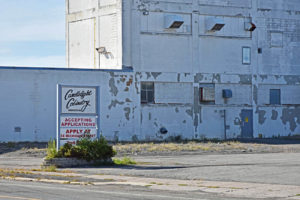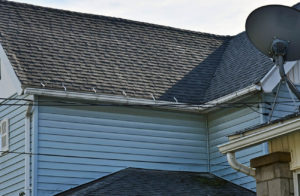Bright Street reeling from Candlelight’s noxious exhaust; DEC working toward firm’s compliance

You can’t see it, but on Bright Street at any given moment, it can smell like there’s an open container of varnish under your nose.
The smell and unseen fumes emanate from nearby Candlelight Cabinetry, which brought its operations to Michigan Street after ex-Lockport Mayor Michael Tucker sold the company that street for $1.
Now residents of Bright Street have been reporting a varnish-type smell that intermittently plagues the street for hours at a time, causing headaches and sore throats as well as the discoloration of the vinyl siding on residents’ houses, they say.
New York State’s Department of Environmental Conservation has been called in to work with the company to bring it into compliance.
On Monday, the head of Buffalo’s DEC, Alan Zylinski, re-visited the west-end neighborhood after he received another complaint about the fumes, which this reporter experienced as well as talking to neighbors who remarked on the strong smell.
Candlelight Cabinetry’s Michigan Street office was visited to speak with a company representative, Todd Manchester, who for the second time, declined to be interviewed about the fumes that blow down Bright Street — most likely due to the positioning of the relatively short 20’ exhaust stacks and weather patterns that blow it straight across to the residential area.

Candlelight Cabinetry is working with an environmental firm from Orchard Park to become compliant with DEC regulations.
An environmental consulting firm from Orchard Park, Hazardous Solutions, has been hired by Candlelight Cabinetry to become compliant with DEC regulations.
“DEC reviewed plans in 2015 which had been submitted by a consultant hired by Candlelight Cabinetry to perform an investigation and recommend measures to eliminate saw dust disposal on a nearby roadway and to limit odor emissions into the environment,” said Megan Gollwitzer from the Buffalo-region DEC office.
“Candlelight implemented measures to address these issues and continues to investigate additional remedial measures. The DEC is working with Candlelight to ensure compliance with DEC laws and regulations,” she said.
Questions posed to Gullwitzer still waiting for answers include: the names of the specific chemicals used during the varnishing process and how much is applied each day? Are there are any plans to increase the height of the exhaust stacks? And what about the health of the workers inside?
Some residents who were asked about the fumes said they couldn’t smell them or said they were not bothered, including employees at one business in the affected area.
However, the ones who do smell it — and say it’s affecting their health — they are waiting for answers about an end to the noxious smell blowing down their street and in their homes.

Residents says houses downwind from Candlelight Cabinetry are experiencing strange discolorations.








































